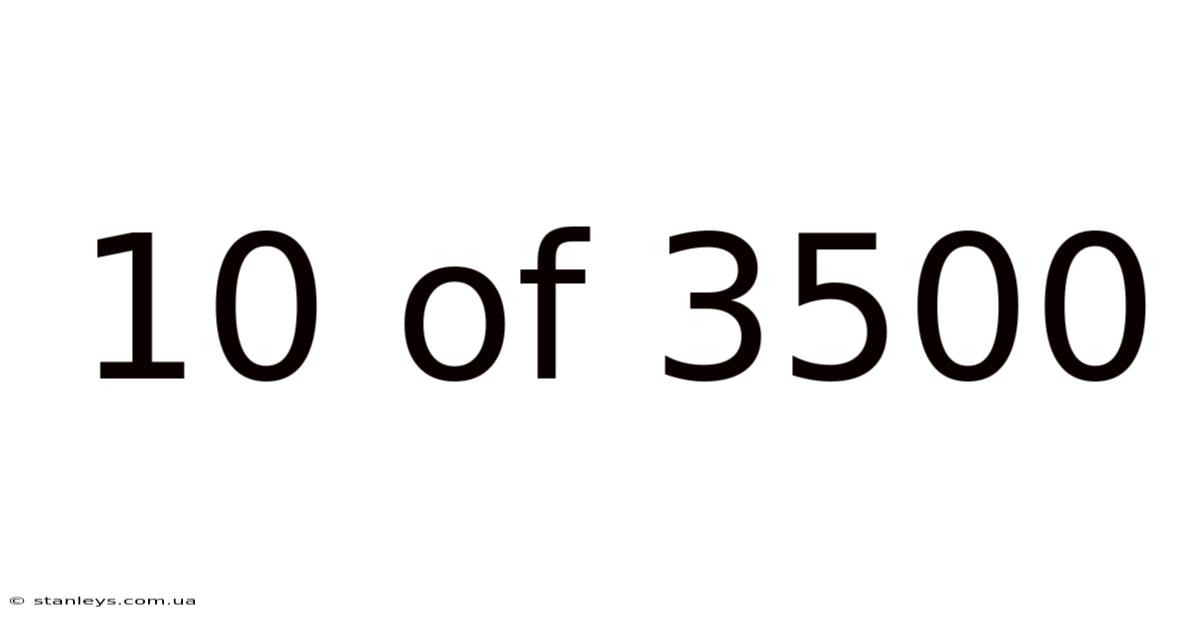10 Of 3500
stanleys
Sep 14, 2025 · 5 min read

Table of Contents
Decoding the Mystery: Understanding the Fraction 10/3500 and its Applications
The seemingly simple fraction 10/3500 might appear insignificant at first glance. However, understanding this fraction, simplifying it, and exploring its applications reveals a deeper appreciation for the principles of mathematics and its real-world relevance. This article will delve into the intricacies of 10/3500, demonstrating how to simplify it, exploring its decimal equivalent, and illustrating its practical use in various contexts. We'll cover everything from basic fraction simplification to more advanced concepts, making this a comprehensive guide for anyone looking to grasp this specific fraction and broader mathematical concepts.
Simplifying the Fraction 10/3500
The first step in understanding 10/3500 is to simplify it to its lowest terms. Simplification involves finding the greatest common divisor (GCD) of the numerator (10) and the denominator (3500) and dividing both by it.
Let's break down the process:
-
Find the factors of 10: The factors of 10 are 1, 2, 5, and 10.
-
Find the factors of 3500: The factors of 3500 are numerous, but we're looking for the greatest common factor with 10. We can start by noticing that 3500 is divisible by 10 (3500/10 = 350).
-
Identify the GCD: The greatest common divisor of 10 and 3500 is 10.
-
Simplify the fraction: Dividing both the numerator and the denominator by 10 gives us:
10/10 / 3500/10 = 1/350
Therefore, the simplified form of the fraction 10/3500 is 1/350. This simplified fraction is much easier to work with in calculations and provides a clearer understanding of its magnitude.
Converting 1/350 to a Decimal
While the fraction 1/350 is useful in some contexts, it's often beneficial to convert it to a decimal for easier comparison and application in various calculations. To convert a fraction to a decimal, you simply divide the numerator by the denominator:
1 ÷ 350 ≈ 0.002857
Therefore, the decimal equivalent of 1/350 (and thus 10/3500) is approximately 0.002857. The "≈" symbol indicates that this is an approximation, as the decimal representation of 1/350 is a repeating decimal.
Real-World Applications of 10/3500 (or 1/350)
While 10/3500 might seem like an abstract mathematical concept, its representation (1/350) finds applications in various real-world scenarios. Let's explore some examples:
-
Percentage Calculations: Imagine a scenario where 10 out of 3500 people in a survey responded positively to a particular question. To express this as a percentage, we can use the simplified fraction:
(1/350) * 100% ≈ 0.2857%
This shows that approximately 0.29% of the surveyed population responded positively.
-
Probability: Consider a situation where there's one winning ticket among 350 raffle tickets. The probability of winning with one ticket is 1/350. This represents the chance or likelihood of a specific event occurring.
-
Rate Calculations: Suppose a machine produces 350 units in an hour. The rate of production of one unit could be represented as 1/350 of an hour per unit. This could be useful in scheduling production, inventory management, or efficiency analyses.
Understanding the Magnitude: Comparing to Other Fractions
Comparing 1/350 to other common fractions helps to visualize its magnitude. It's significantly smaller than 1/100 (1%), 1/10 (10%), or even 1/50 (2%). This small magnitude underscores its potential use in representing low probabilities or small proportions within larger datasets.
Advanced Concepts: Ratios and Proportions
The fraction 10/3500, in its simplified form 1/350, represents a ratio. A ratio is a comparison of two quantities. In this case, it compares one part to 350 parts. This ratio can be used to solve various proportion problems. For example:
-
Scaling: If we know one part of a mixture consists of one unit, and the total mixture consists of 350 units, we can use this ratio to scale up or down the quantities of each component in the mixture.
-
Direct Proportion: If the amount of work done is directly proportional to the time spent, and one unit of work takes 1/350 of an hour, we can easily calculate the time required for larger amounts of work.
Frequently Asked Questions (FAQ)
Q: Can 10/3500 be simplified further after getting 1/350?
A: No, 1/350 is the simplest form of the fraction because the greatest common divisor of 1 and 350 is 1.
Q: What is the percentage equivalent of 10/3500?
A: Approximately 0.29%.
Q: How do I convert a fraction to a decimal?
A: Divide the numerator by the denominator.
Q: Are there other real-world applications of this type of fraction?
A: Yes, many fields use small fractions to represent rates, proportions, or probabilities in various calculations and analyses, particularly in science, engineering, finance, and statistics.
Conclusion: The Significance of Small Fractions
While seemingly insignificant, the fraction 10/3500, simplified to 1/350, offers valuable insights into the world of fractions, decimals, ratios, and their applications. Understanding its simplification, decimal equivalent, and real-world uses enhances mathematical proficiency and problem-solving skills. The ability to work with such fractions demonstrates a fundamental grasp of mathematical principles and their practical utility in diverse fields. Remember, even small fractions hold significance, showcasing the power of precision and detail in mathematical calculations and analysis. This seemingly simple fraction serves as a microcosm of the broader mathematical landscape, highlighting the interconnectedness of different concepts and their pervasive relevance in our daily lives. By understanding the seemingly insignificant, we unlock a deeper appreciation for the power of mathematics and its applications.
Latest Posts
Latest Posts
-
Concrete Frame Construction
Sep 14, 2025
-
34kg To Stone
Sep 14, 2025
-
Shah Mosque Isfahan
Sep 14, 2025
-
75 Of 12
Sep 14, 2025
-
103f To C
Sep 14, 2025
Related Post
Thank you for visiting our website which covers about 10 Of 3500 . We hope the information provided has been useful to you. Feel free to contact us if you have any questions or need further assistance. See you next time and don't miss to bookmark.